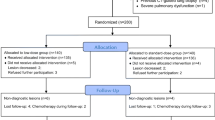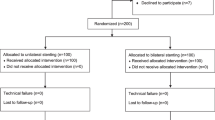Abstract
Purpose
Mediastinal, hilar, and peripheral pulmonary lymphadenopathy is a hallmark sign of different benign and malignant diseases of the chest. Contrast-enhanced (CE) chest CT is a test frequently applied to examine thoracic lymph node zones. We attempted to find out whether mediastinal, hilar, and peripheral lymph nodes delineate equally in CE chest CT with reduced dose (CE-LDCT, about 1 mSv) when compared with accepted standard CE chest CT (CE-SDCT).
Materials and methods
In this ethics committee-approved, mono-institutional, retrospective (20 months) matched case–control study, two independent, blinded observers compared measurable lymph node delineation (yes–no) in six different International Association for the Study of Lung Cancer (IASLC) zones (upper mediastinal, aortopulmonary, subcarinal, lower mediastinal, hilar, peripheral) between 62 CE-LDCT cases and 124 CE-SDCT controls (respective tube charge, 100, 120 KVp, computed tomography dose index, 1.66 ± 0.51, 5.36 ± 2.24 mGy, automatic exposure control-modulated 64-row multi-detector chest CT with iterative image reconstruction). Individual matching for gender (53% female), age (53 ± 19 years), body height, weight, anterior–posterior and transverse diameters of chest and lung ruled out pre-test confounders. Lymph node size (cut-off value, 1 cm) was a potential post-test confounder. Two-tailed T test and Chi-square test were significant for p < 0.05.
Results
Measurable lymph nodes delineated equally in cases (261/372 IASLC zones, 70%; 280/372, 75%) and controls (528/744, 71%; 519/744, 70%; no significant differences, power 90%). One observer delineated significantly more peripheral zone lymph nodes in cases (35/62) than in controls (43/124); there were no significant differences otherwise. Lymph node size did not differ significantly; effective dose was 1.0 ± 0.3 mSv in cases and 3.4 ± 1.5 mSv in controls.
Conclusion
CE-LDCT with about 1 mSv demonstrated equal delineation of thoracic lymph nodes when compared with accepted standard CE-SDCT.




Similar content being viewed by others
Abbreviations
- AEC:
-
Automatic exposure control
- BMI:
-
Body mass index
- CE:
-
Intravenous contrast enhancement or intravenously contrast-enhanced
- CE-LDCT:
-
Contrast-enhanced highly dose-saving computed tomography of the chest
- CE-SDCT:
-
Contrast-enhanced computed tomography of the chest with standard dose
- CT:
-
Computed tomography
- CTDI:
-
Computed tomography dose index
- DLP:
-
Dose length product
- ED:
-
Effective dose
- EK:
-
Conversion factor of EUR 16262 EN
- IASLC:
-
International Association for the Study of Lung Cancer
- IIR:
-
Iterative image reconstruction
- LDCT:
-
Highly dose-saving computed tomography of the chest
- MDCT:
-
Multi-detector row-computed tomography
- PACS:
-
Picture archiving and communication system
- SD:
-
Standard deviation
- SDCT:
-
Computed tomography of the chest with standard dose
References
Foley SJ, McEntee MF, Rainford LA (2012) Establishment of CT diagnostic reference levels in Ireland. Br J Radiol 85:1390–1397
Shrimpton PC, Hillier MC, Meeson S et al (2014) Doses from computed tomography (ct) examinations in the UK—2011 review. Public Health England, Centre for Radiation, Chemical and Environmental Hazards, September, 2014. PHE publications gateway number: 2014179. www.gov.uk/phe. Accessed 16 May 2016
Mayo JR, Aldrich J, Muller NL et al (2003) Radiation exposure at chest CT: a statement of the Fleischner Society. Radiology 228:15–21
Federal Office for Radiation Protection (2015) Radiation topics: X-ray diagnosis—harmful or useful? Salzgitter, Germany: Federal Office for Radiation Protection; September, 2015. https://www.bfs.de/SharedDocs/Downloads/BfS/DE/broschueren/ion/stth-roentgen.pdf. Accessed 16 May 2016 (in German)
Kanal KM, Butler PF, Sengupta D et al (2017) U.S. diagnostic reference levels and achievable doses for 10 adult CT examinations. Radiology 284:120–133
Bundesministerium fuer Umwelt, Naturschutz, Bau und Reaktorsicherheit (2015) Umweltradioaktivitaet und Strahlenbelastung Jahresbericht 2013. BMUB, Bonn, Germany (in German, Summary in English, French, and German)
Söderberg M, Gunnarsson M (2010) Automatic exposure control in computed tomography–an evaluation of systems from different manufacturers. Acta Radiol 51:625–634
Mueck FG, Michael L, Deak Z et al (2013) Upgrade to iterative image reconstruction (IR) in MDCT imaging: a clinical study for detailed parameter optimization beyond vendor recommendations using the adaptive statistical iterative reconstruction environment (ASIR) part 2: the chest. Rofo 185:644–654
Coppenrath E, Mueller-Lisse UG, Lechel U et al (2004) Low-dose spiral CT of the lung in the follow-up of non-malignant lung disease. RoFo Fortschr auf dem Gebiete der Rontgenstrahlen und der Nukl 176:522–528
Deutsche Gesetzliche Unfallversicherung (DGUV) (2011) Falkensteiner Empfehlung - Empfehlung für die Begutachtung asbestbedingter Berufskrankheiten. Berlin, Germany. http://publikationen.dguv.de/dguv/udt_dguv_main.aspx?FDOCUID=25466. Accessed 16 May 2016 (in German)
Bongartz G, Golding SJ, Jurik AG et al (2004) Appendix B—European field survey on MSCT. In: European guidelines for multislice computed tomography. Funded by the European Commission, Contract number FIGM-CT2000-20078-CT-TIP. http://www.msct.eu/CT_Quality_Criteria.htm. Accessed 16 May 2016
Friberg EG, Widmark A, Ryste Hauge ICH (2009) National collection of local diagnostic reference levels in Norway and their role in optimization of X-ray examinations. Norwegian Radiation Protection Authority, Østerås
Federal Office for Radiation Protection (2015) Notice of diagnostic reference levels for radiology and nuclear medicine examinations. Federal Office for Radiation Protection, Salzgitter, Germany. https://www.bfs.de/SharedDocs/Downloads/BfS/DE/fachinfo/ion/drw-roentgen.pdf. Accessed 16 May 2016 (in German)
Buty M, Xu Z, Wu A et al (2017) Quantitative image quality comparison of reduced- and standard- dose dual-energy multiphase chest, abdomen, and pelvis CT. Tomography 3:114–122
Ebner L, Knobloch F, Huber A et al (2014) Feasible dose reduction in routine chest computed tomography maintaining constant image quality using the last three scanner generations: from filtered back projection to sinogram-affirmed iterative reconstruction and impact of the novel fully integrated detector design minimizing electronic noise. J Clin Imaging Sci 4:38. https://doi.org/10.4103/2156-7514.137826
Suwatanapongched T, Gierada DS (2006) CT of thoracic lymph nodes. Part II: diseases and pitfalls. Br J Radiol 79:999–1000
Sharma A, Fidias P, Hayman LA et al (2004) Patterns of lymphadenopathy in thoracic malignancies. Radiographics 24:419–434
Paolini M, Wirth K, Tufman A et al (2016) Thoracic lymph node delineation at dose-reduced (1 mSv) dose-modulated contrast enhanced MDCT: a retrospective pilot study. Radiol Med 121:644–651
von Elm E, Altman DG, Egger M et al (2007) The strengthening the reporting of observational studies in epidemiology (STROBE) statement: guidelines for reporting observational studies. PLoS Med 4:e296. https://doi.org/10.1371/journal.pmed.0040296
Menzel HG, Schibilla H, Teunen D (eds.). European guidelines on quality criteria for computed tomography. EUR 16262 EN. http://www.drs.dk/guidelines/ct/quality/mainindex.htm. Accessed 16 May 2016
Rusch VW, Asamura H, Watanabe H et al (2009) The IASLC lung cancer staging project: a proposal for a new international lymph node map in the forthcoming seventh edition of the TNM classification for lung cancer. J Thorac Oncol 4:568–577
Kim JH, van Beek EJR, Murchinson JT et al (2015) The international association for the study of lung cancer lymph node map: a radiologic atlas and review. Tuberc Respir Dis 78:180–189
Jawad H, Sirajuddin A, Chung JH (2013) Review of the international association for the study of lung cancer lymph node classification system: localization of lymph node stations on CT imaging. Clin Chest Med 34:353–363
Hulley SB, Cummings SR, Browner WS et al (2007) Estimating sample size and power: applications and examples. In: Hulley SB, Cummings SR, Browner WS, Grady DG, Newman TB (eds) Designing clinical research, chapter 6, 3rd edn. Lippincott Williams and Wilkins, Philadelphia, pp 65–96
Glantz SA (1997) How to analyze rates and proportions. In: Glantz SA (ed) Primer of biostatistics, chapter 5, 4th edn. McGraw-Hill Health Professions Division, New York, St. Louis, San Francisco, Auckland, Bogota, Caracas, Lisbon, London, Madrid, Mexico City, Milan, Montreal, New Delhi, San Juan, Sydney, Tokyo, Toronto, pp 108–150
Landis JR, Koch GG (1977) The measurement of observer agreement for categorical data. Biometrics 33:159–174
Glantz SA (2012) The special case of two groups: the t-test. In: Glantz SA (eds) Primer of biostatistics, chapter 4, . 7th edn. McGraw-Hill Medical, New York Chicago San Francisco Lisbon London Madrid Mexico City Milan New Delhi San Juan Seoul Singapore Sydney Toronto, pp 49–72
Jaffe TA, Yoshizumi TT, Toncheva G et al (2009) Radiation dose for body CT protocols: variability of scanners at one institution. AJR Am J Roentgenol 193:1141–1147
Nambu A, Kato S, Motosugi U et al (2010) Thin-section CT of the mediastinum in preoperative N-staging of non-small cell lung cancer: comparison with FDG PET. Eur J Radiol 73:510–517
Bundesamt für Strahlenschutz (2016) Diagnostic reference values for diagnostic and interventional X-ray applications. Salzgitter, Germany, BAnz AT 15.07.2016 B8. https://www.bfs.de/SharedDocs/Downloads/BfS/DE/rsh/rsh/A25-Roentgen-DRW.pdf;jsessionid=17BC3192738EDB6864E5A4D1BFB14504.1_cid391?__blob=publicationFile&v=1. Accessed 11 October 2016 (in German)
Khawaja RD, Singh S, Gilman M et al (2014) Computed tomography (CT) of the chest at less than 1 mSv: an ongoing prospective clinical trial of chest CT at submillisievert radiation doses with iterative model image reconstruction and iDose4 technique. J Comput Assist Tomogr 38:613–619
Yamada T, Ono S, Tsuboi M et al (2004) Low-dose CT of the thorax in cancer follow-up. Eur J Radiol 51:169–174
Dinkel HP, Sonnenschein M, Hoppe H et al (2003) Low-dose multislice CT of the thorax in follow-up of malignant lymphoma and extrapulmonary primary tumors. Eur Radiol 13:1241–1249
Vorwerk H, Beckmann G, Bremer M et al (2009) The delineation of target volumes for radiotherapy of lung cancer patients. Radiother Oncol 91:455–460
Acknowledgements
This manuscript includes results of doctoral thesis work in preparation by Larissa Marwitz at the Faculty of Medicine of the University of Munich (“Ludwig-Maximilians-Universität”, LMU), Germany. Authors acknowledge the kind support of their research activities by Professors Maximilian F. Reiser and Jens Ricke, Directors of the Department of Radiology of the Faculty of Medicine of the University of Munich (“Ludwig-Maximilians-Universität”, LMU), Germany.
Author information
Authors and Affiliations
Corresponding author
Ethics declarations
Conflict of interest
All authors declare that there is no conflict of interest.
Ethical standards
This was a retrospective study. It was performed in accordance with the Declaration of Helsinki and approved by the local ethics committee. This article does not contain any studies with animals.
Rights and permissions
About this article
Cite this article
Mueller-Lisse, U.G., Marwitz, L., Tufman, A. et al. Less radiation, same quality: contrast-enhanced multi-detector computed tomography investigation of thoracic lymph nodes with one milli-sievert. Radiol med 123, 818–826 (2018). https://doi.org/10.1007/s11547-018-0915-2
Received:
Accepted:
Published:
Issue Date:
DOI: https://doi.org/10.1007/s11547-018-0915-2




